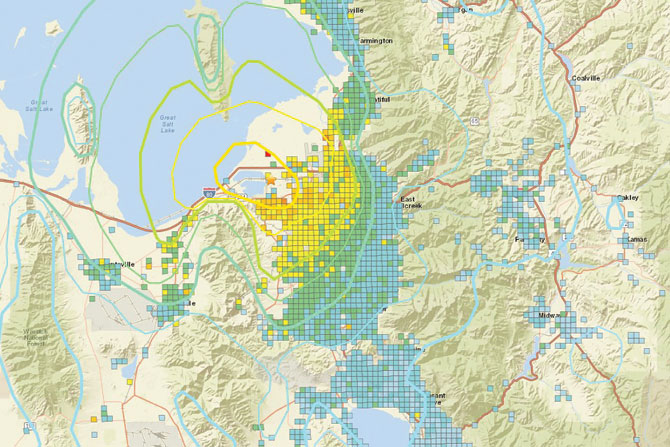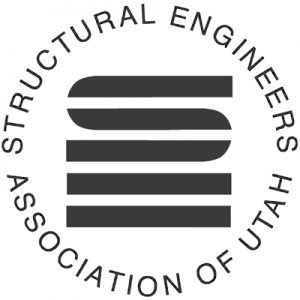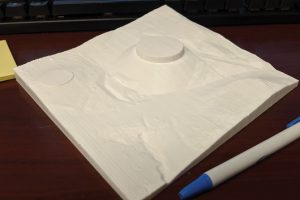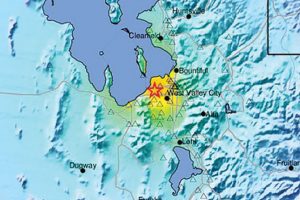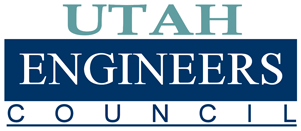Many of you reading this article experienced the shaking from the Magna Earthquake on March 18, 2020. You may have also wondered how it compared to what we would experience in the “Big One.” During the Magna earthquake, the shaking was felt from Utah County to Cache County and beyond. If you experienced the earthquake, how would you describe the shaking that occurred where you were? Was it weak, light, moderate, strong, severe, violent, or extreme? How long did the shaking last? Each reader’s answer to these questions will likely be different depending on where they were during the earthquake.
This article will discuss earthquake shaking, earthquake magnitude, and building performance for specific levels of shaking. It will also help paint a picture of the substantial effect on buildings from a Wasatch fault earthquake, which has the potential to generate shaking levels significantly higher than the building code requires new buildings to be designed for.
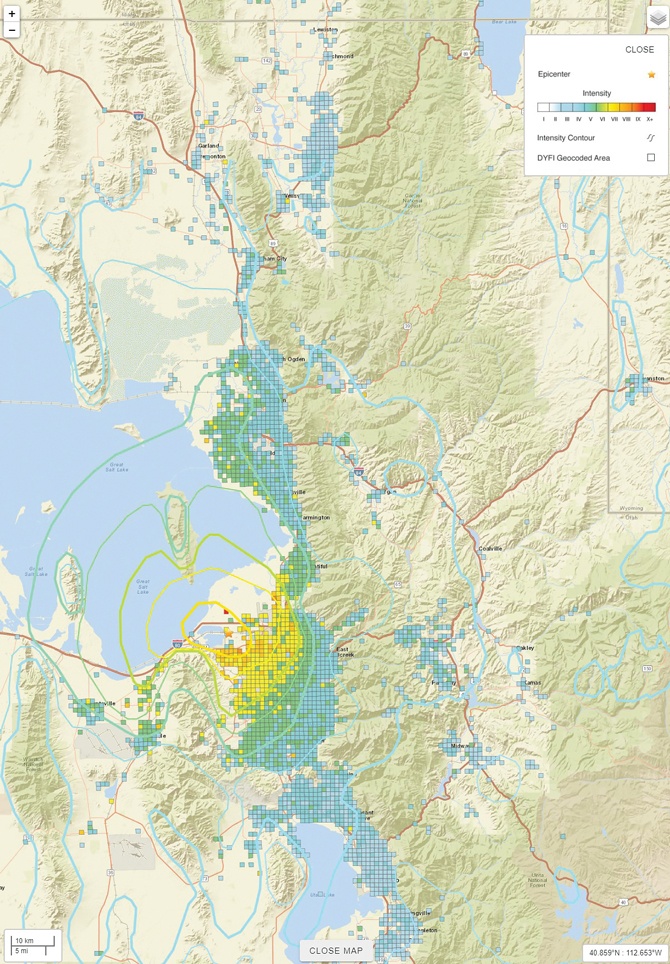
Figure 1 maps how people who felt the shaking reported what they felt. The blue colors are weak to light shaking. The green colors are moderate shaking. The yellow colors are strong shaking, and the orange colors are very strong shaking. (See the key in Figure 2.) Notice how the yellows and orange colors are clustered close to the epicenter. We learn several things from this map.
- Shaking varies in every earthquake. Every location does not experience the same shaking.
- Shaking decreases with distance.
- The shaking was not severe (dark orange), violent (red), or extreme (dark red).
- Earthquakes cause the ground to shake, and it is important to understand the shaking intensity in addition to the magnitude of the earthquake.
Almost all the damage occurred in areas that experienced the yellow (strong) and orange (very strong) shaking. Most of the damage occurred to unreinforced masonry buildings (URM), which are very prone to damage or collapse in earthquakes. Figure 3 shows shaking intensities for various recent earthquakes, and Figure 4 shows the Magna Earthquake and a Scenario Wasatch Fault 7.0 earthquake generated by the U. S. Geological Survey (USGS). Notice the variations in shaking in each of these earthquakes. The scales and areas are identical in each of the images shown in the two figures.
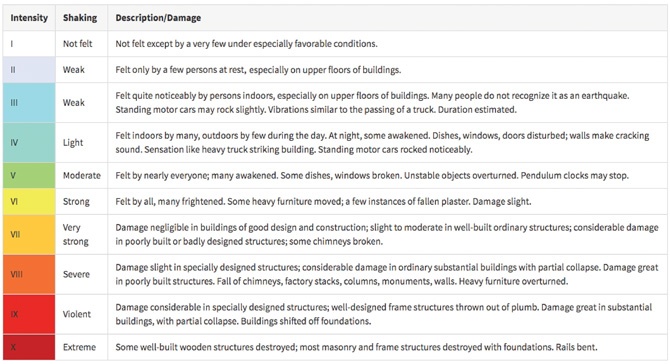
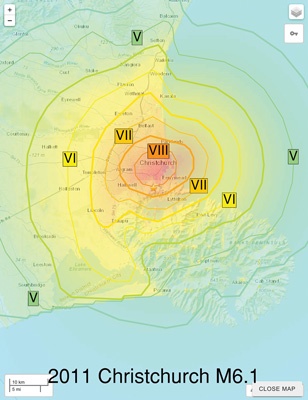
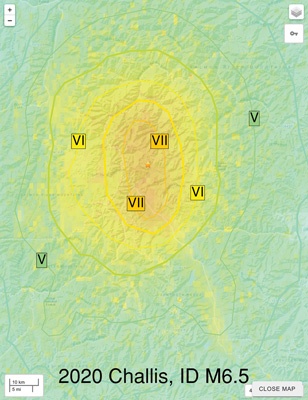
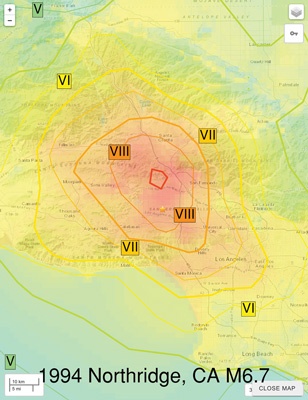
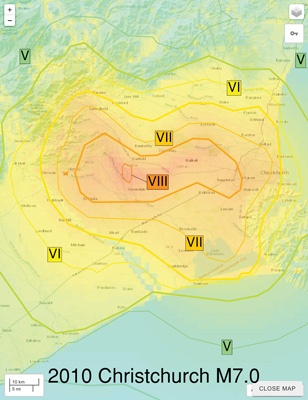
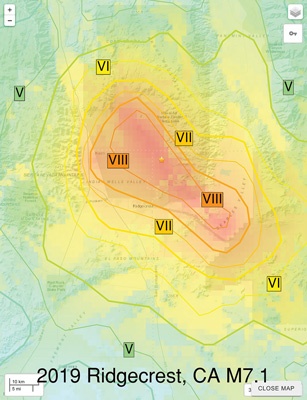

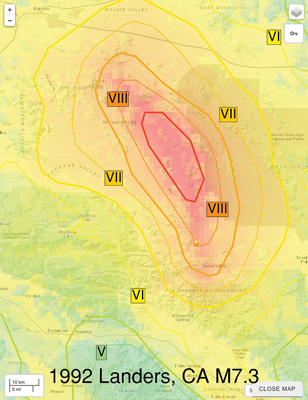
Figure 3.
• 2011 Christchurch M6.1: https://earthquake.usgs.gov/earthquakes/eventpage/usp000huvq/map
• 2020 Challis, ID M6.5: https://earthquake.usgs.gov/earthquakes/eventpage/us70008jr5/map
• 1994 Northridge, CA M6.7: https://earthquake.usgs.gov/earthquakes/eventpage/ci3144585/map
• 2010 Christchurch M7.0: https://earthquake.usgs.gov/earthquakes/eventpage/usp000hk46/map
• 2019 Ridgecrest, CA M7.1: https://earthquake.usgs.gov/earthquakes/eventpage/ci38457511/map
• 1992 Landers, CA M7.3: https://earthquake.usgs.gov/earthquakes/eventpage/ci3031111/map
All accessed March 29, 2020, annotated.
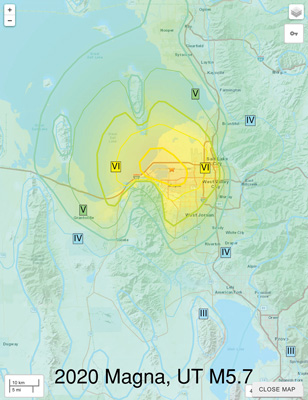
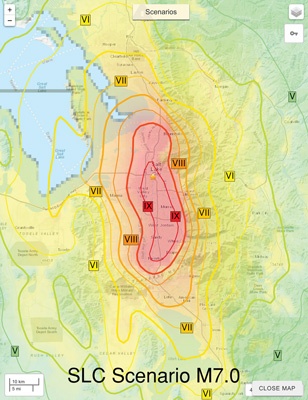
Figure 4. Modified Mercalli Intensity Scale:
https://www.usgs.gov/media/images/modified-mercalli-intensity-scale, accessed April 1, 2021.
• 2020 Magna, UT M5.7: https://earthquake.usgs.gov/earthquakes/eventpage/uu60363602/map
• SLC Scenario M7.0: https://earthquake.usgs.gov/scenarios/eventpage/uulegacyshakeoutff_se/map
Both accessed March 29, 2020, annotated.
Well-engineered modern buildings were not affected other than some minor cracks and broken windows. As the shaking intensity increases to red (violent) or dark red (extreme) shaking, even well-engineered modern buildings can be heavily damaged and might even collapse. We will discuss how buildings could perform from a Wasatch fault earthquake, but first, we want to introduce the concept of code building performance.
We all want our buildings to be life-safe during and after “an earthquake.” We also want our hospitals, fire stations and police stations to be functioning after “an earthquake.” But what is “an earthquake,” and what does life-safe mean? First, “an earthquake” is not specifically addressed in the building code and is not useful for engineers designing buildings. Instead, engineers use a shaking level at the building’s site. The building code is very specific about what “Life Safety” means and even more specific about the level of shaking that engineers should use to achieve “Life Safety” for a building’s design. We will first discuss two building performance levels discussed in the commentary to ASCE 7-16 (the portion of the building code that specifies earthquake forces). Per Section C11.5., “Collapse Prevention” means that a building will have a “suitably low likelihood of collapse,” which is defined by the code as a 10% chance of collapse. “Life Safety” means that “life-threatening damage, primarily from a failure of nonstructural components, is unlikely.” Buildings with damage in either one of these performance states could be heavily damaged, and it could be months before repairs are made to allow them to be reoccupied. In some cases, the cost of repairs will exceed the replacement cost of the building.
Building performance must be associated with a level of shaking for it to have any meaning. One cannot just say, “I want my building to be ‘life safe,’” because there is always a level of shaking where the building will not be “life-safe.” As previously stated, a “Life Safety” performance or a “Collapse Prevention” performance must be associated with a specific level of shaking. The code sets the shaking level at which a new building must have “Collapse Prevention” performance and “Life Safety” performance. The shaking level for “Collapse Prevention” is defined as the Maximum Considered Earthquake shaking (MCER). It is not the highest level of shaking that could ever happen at a location, but it is the highest level of shaking that the code requires engineers to consider. The value of MCER shaking for each location in the U.S. generally has a 1% probability of building collapse in 50 years (1/5000 chance per year). (This article does not discuss the exceptions.) The code sets the level of shaking for which a building must have “Life Safety” performance at 2/3 the value of the MCER shaking.
The code value of MCER shaking along the Wasatch Front is heavily influenced by the long recurrence intervals (average time between large earthquakes) of the different segments of the central Wasatch fault, which are about 1200+/-100 years. The code does not consider the elapsed time since the last major earthquake. If the fault ruptured more often, reducing the recurrence interval, the code required MCER shaking level would be significantly higher along the Wasatch Front than it currently is, and buildings would be required to be stronger.
Let us now summarize and tie this discussion together. We know that a magnitude 7.0 earthquake on the Wasatch fault will cause a wide range of shaking intensities, some of which will be very large. We compared the predicted range of shaking to a short girl (16th percentile) and a tall girl (84th percentile). We introduced the code MCER shaking level and said that a building could have a 10% chance of collapse if it experiences this shaking level. We now need to compare where the code MCER shaking level fits along the range of potential shaking levels that could happen in a large Wasatch fault earthquake. Understanding this relationship will show that the building code does not protect the Wasatch Front from a Wasatch fault earthquake to the level that most people expect. Because of the methodology used to calculate the MCER value, as discussed above, MCER falls at about the median predicted shaking from a large Wasatch fault earthquake. The consequence of this is that there is a 50/50 chance that a site will experience a shaking level that exceeds the MCER. The 84th percentile shaking is about twice the value of MCER in most areas of the Wasatch Front (2.70 versus 1.48 for Ss and 1.16 versus 0.541 for S1 for a site in downtown Salt Lake City).
The scary thing about this factor-of-two difference is that the probability of collapse could jump from 10% to 45% if a building experiences the 84th percentile shaking intensity.
Luckily, most locations will not experience an 84th percentile shaking intensity in a Wasatch fault earthquake (about double MCER), but some areas could be hit with this shaking. Not all buildings that experience shaking levels twice the MCER will collapse, but almost all of them that do experience it will be severely damaged and near collapse. Many newly constructed buildings in areas that experience the median predicted shaking intensity will be severely damaged, and a few could collapse. The 2/3*MCER shaking level is in the range of the 25th to 35th percentile, which means that there is a high likelihood that most buildings will experience a shaking that exceeds the 2/3*MCER “Life Safety” shaking level. Since most buildings will experience damage that could exceed “Life Safety,” there could be many deaths from falling hazards.
Why would the building code allow for so much damage and risk of collapse from a Wasatch fault earthquake? The code uses a specific methodology across the United States to calculate the MCER shaking level. The Wasatch Front is in a somewhat unique situation because there is one very large fault with a long recurrence interval and many smaller faults. This combination tends to lower the value of MCER compared to some other areas of the country that have multiple large faults with shorter recurrence intervals. The SEAU Technical committee wants to study the impact that a Wasatch fault earthquake could have on the Wasatch Front.
We want to quantify and compare the economic and life safety impact from staying with the current building code methodology, as described above, compared to enhancing the code to ensure that buildings that receive the 84th percentile shaking intensity have no more than a 10% chance of collapse. (The 84th percentile shaking level is required by the building code to be used in areas of the country where large earthquakes happen frequently. It is also often used when designing for a specific earthquake scenario.) We are seeking funding for this study.
The building code is based on an acceptable risk set by the code writers; however, the Wasatch Front’s unique aspects may create higher potential consequences from a Wasatch fault earthquake than what many people expect or desire from the building code. Once the risks are quantified, we can have informed discussions about what to do about it. The code allows concerned owners to design and construct new buildings beyond the risk provided by the code. Please speak to your structural engineer about your desired building performance levels at specific levels of shaking, especially as it relates to shaking from a Wasatch fault earthquake.

Brent Maxfield, S.E.
Brent Maxfield, S.E., is a member of the SEAU Technical Committee and the Seismic Subcommittee Co-Chair. He has been employed as a structural engineer in the Special Projects Department of The Church of Jesus Christ of Latter-day Saints for almost 29 years. In 2012, he was selected the Utah Engineer of the Year by the Utah Engineers Council. He loves spending time with his wife, five sons, and their families exploring Utah’s great outdoors.

Eric Hoffman, S.E.,
Eric Hoffman, S.E., is SEAU’s Technical Committee Chair and is a project manager with Ensign Engineering, Inc. He received his B.S. and M.S. degrees in Civil Engineering from Brigham Young University; is a licensed professional engineer in Arizona, Utah and California; and has Structural licenses in Utah and California. Eric lives with his wife and four children in Springville, Utah.



